Fly Fishing For Trout: 39 Tips For More Trout
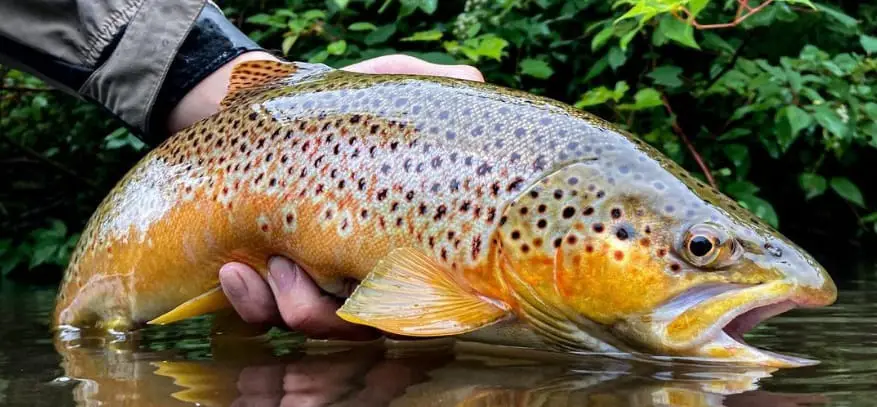
This is the most comprehensive guide on fly fishing for trout on the internet and it’s guaranteed to help beginners and advanced fly anglers since I’ll be sharing guide tips I’ve learned as a fishing guide for over 20 years.
Catching trout on a fly rod is actually easier than you think, especially if you know what you are doing. Catching trout on a fly rod consistently comes down to understanding the trout, when and how to fish for them, and which fly fishing methods and flies to use.
With the help of other guides, I have created a list of the 39 most important things that we teach our clients to make trout fly fishing easier, less frustrating, and more fun for them.
Catching trout while fly fishing requires suitable fly fishing equipment, some flies, and the knowledge of which rivers are good for trout in your area. Once you have that figured out, the next step is learning how to read the water, and which method of fly fishing is best.
Key Takeaways
| Topic | Details |
|---|---|
| 5 Methods Of Fly Fishing | Learn about the methods used in fly fishing and which ones are the most effective. Nymphing, Dry Fly fishing, Streamer fishing, and Wet Fly fishing |
| Fishing and Catching | Get knowledge of good trout rivers, and understanding how to read water and the common mistakes anglers make that can be avoided. |
| Trout Flies | Learn the fly used for different methods of fly fishing. It’s essential to match the size, shape, and color of natural insects or baitfish when choosing flies. Tips on choosing the right flies |
| Casting & Presention | Different casting techniques are required based on the fly’s size and weight. Achieving a natural drift, or “dead drift,” is crucial for success. |
| Gear & Equipment | Using the right gear, including a suitable net, is essential for successful fly fishing and the safe release of trout. |
| Guide Tips | Find out what trout guides do to catch more tip. Get many guide tips to make fly fishing easier to understand and to help all fly anglers catch more trout. |
Fly Fishing For Trout Basics
I’ve had many clients catching trout on their first or second cast or within 5 minutes of fishing, and these are guys who have never even touched a fly rod before.
To get my clients to catch trout as fast as possible, I follow the same basic steps, and this should be followed by all fly fishermen:
- I set up their rod and line for the right method, which is based on the current conditions.
- I put on a good fly based on the conditions.
- I put my client in the right spot based on my knowledge of trout holding and feeding spots.
- I tell them what to do or how to fish the spot, and this is based on the conditions and the type of water.
- And then they catch fish, so I teach them how to fight and land the trout.
These are the simple steps that all guides use to consistantly catch trout when fly fishing.
The problem is most inexpereinced fly anglers make common mistakes that prevent them from catching fish, and they don’t even realize it. My tips will helk you identify these mistakes. But lets discuss some basics first.
The Fly Fishing Difference

The difference between spin fishing and fly fishing is that when spin fishing, the weight of the lure or bait pulls the line out toward the trout, but when you fly fish, it’s actually the weight of the line that pulls the fly out to the fish.
The Fly Size For Trout
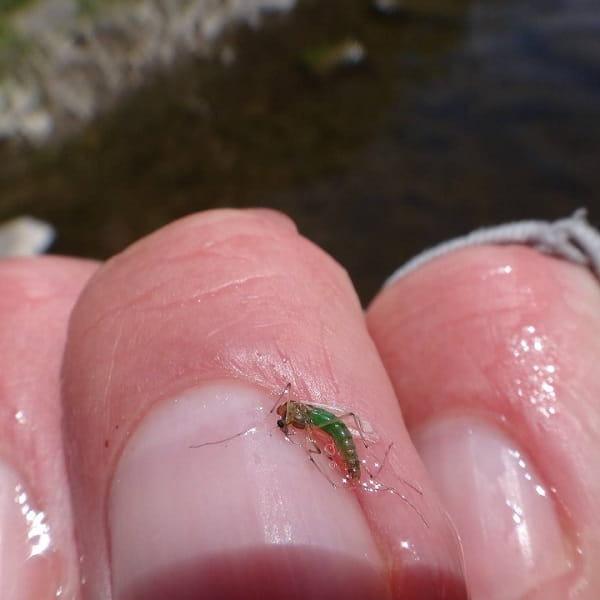
Fly line is heavy, and it’s the fly line that carries the fly out to where the fish should be.
The reason we need the fly line to cast the fly is that when we fly fish for trout, we often use artificial flies as small and as light as a mosquito. They are so light that they can’t be cast with traditional rods and line, unless you add weights to the leader.
Additional weights won’t do you any good if you want that fly to float on the surface.
Fly Fishing Trout From Top To Bottom
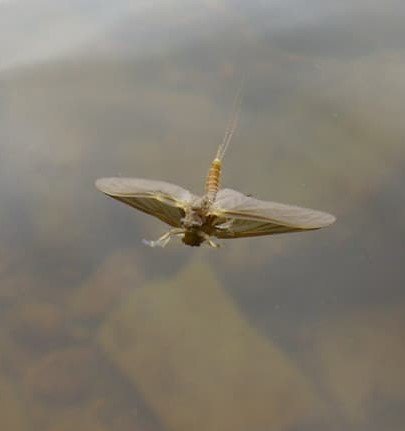
Fly fishing allows the angler to fish very light floating flies on the water’s surface to imitate aquatic insects or other types of bait that might be on the surface of the water. This is called dry fly fishing.
Catching trout while fly fishing can be done by drifting your flies below the surface too. We do this to imitate aquatic insects, fish eggs, baitfish, crustaceans, or other aquatic animals found in the river or lake. This is called nymphing.
With fly fishing, you can effectively fish all parts of the water column.
Fly Fishing Trout In Lakes, Ponds, And Rivers
You can fly fish for trout on lakes and ponds, but the most popular place to catch trout with a fly rod is on cold water rivers and streams for trout.
1. There Are 4 Methods to Fly Fish For Trout
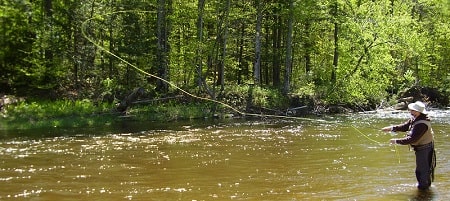
There are four common fly fishing techniques that anglers use when trout fishing, and one lesser-known method that I will also briefly mention.
Each method is different and serves a different purpose. As an angle, you should know which method you should use based on the type of water, the conditions, and the trout’s feeding behavior.
The four methods of fly fishing are, Nymphing, Dry Fly fishing, Streamer fishing, and Wet Fly fishing, and if you want to know the 5th fly fishing method, it is Spey fishing.
2. Nymphing: Know What It Is And When To Use It
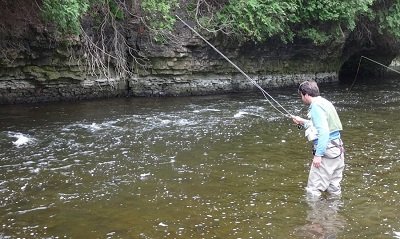
Nymphing is an effective and popular fly fishing method to catch trout below the surface. There are a few versions of nymphing and some methods can be more effective in certain situations.
What Is Nymphing?
Nymphing is simply drifting a fly below the surface in a dead drift and it is usually done in a river or stream.
Dead drift means you are allowing your fly to drift naturally with the current without pulling it or as fly anglers say, “without drag”. You nay hear the term “drag free drift”, this is the same a the “dead drift.”
When To Nymph For Trout?
Nymphing is best done when the trout are feeding below the surface or when you don’t see any surface activity. However, even when fish are feeding on the surface, nymphing can still be good.
It is said that “90% of the trout’s diet is below the surface.” Therefore, it is wise to learn how to nymph fish for trout.
3. Know The Right Nymphing Method To Use
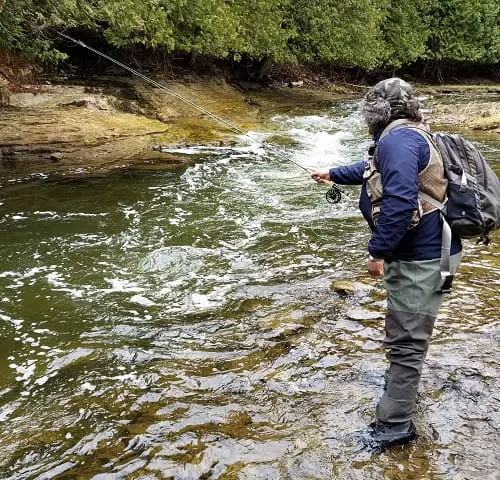
There are three methods of nymphing that you should know about, and you should also know when to use each of them if you want to maximize your success.
Using the wrong nymphing method can lead to 90% fewer fish.
The three types of nymphing are Indicator Nymphing, Tight Line Nymphing, and Euro Nymphing.
Click the link for more in-depth details on Nymph fishing for trout, which includes using multiple flies, effective leaders setups, and best flies.
4. Learn Indicator Nymphing

Indicator nymphing is the most common method of nymph fishing in North America, and it has been for over 30 years.
Twenty years ago, I would bet 95% of river guides used this method of nymphing for trout with their clients.
Indicator nymphing works best in larger, deeper rivers, or on smaller streams that have deeper spots that are over three feet deep. Nymph fishing also works well in slower water spots.
Indicator nymphing is usually not the best method in spots less than 3 feet deep on a gin-clear river. This is because the indicator will likely be seen by the fish and then spook fish, so many anglers use a method known as Euro Nymphin in shallow water.
Pro Tip: In some areas, you are permitted to use two or three flies. I prefer and always use two flies if I am allowed, and I have some very effective 2 Fly Set Ups.
5. Learn Euro Nymphing
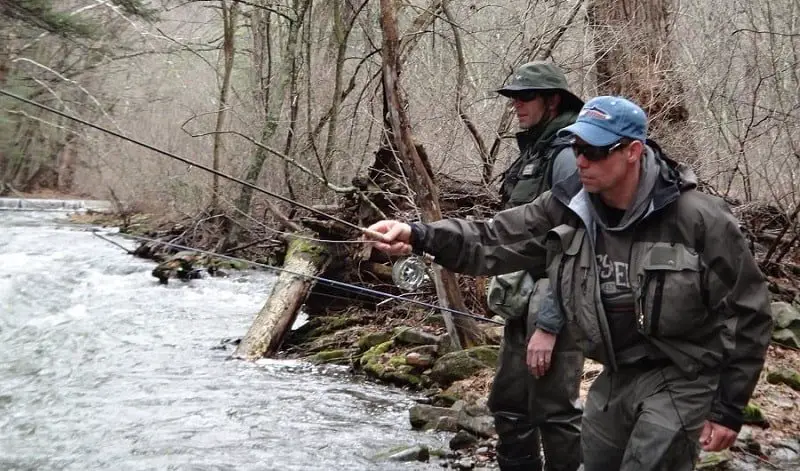
The method I use and recommend in low clear water is Euro Nymphing.
Euro nymphing, which is also called Tight-line Nymphing or Modern Nymphing, is the most effective method of trout fly fishing.
Euro nymphing is the best method on spots less than 5 feet deep, and it can’t be beaten in spots under three feet deep, in faster water, and in pocket water. It’s also far more effective in gin-clear water because there is no indicator to spook the fish.
I tell my clients to go back to indicator fishing when it’s very windy or in dee, slow water Switch back and forth based on the conditions.
If you want to nymph small streams and want to catch the most fish possible, especially in shallow water, do what the experts do, use Euro Nymphing methods.
Pick Your Fly
Fly choice is a debatable topic, and everyone has their own opinions, but it doesn’t need to be that difficult. As a beginner to trout fly fishing, there are two things to consider. Match the size, and match color.
6. Choose Seasonal Trout Flies
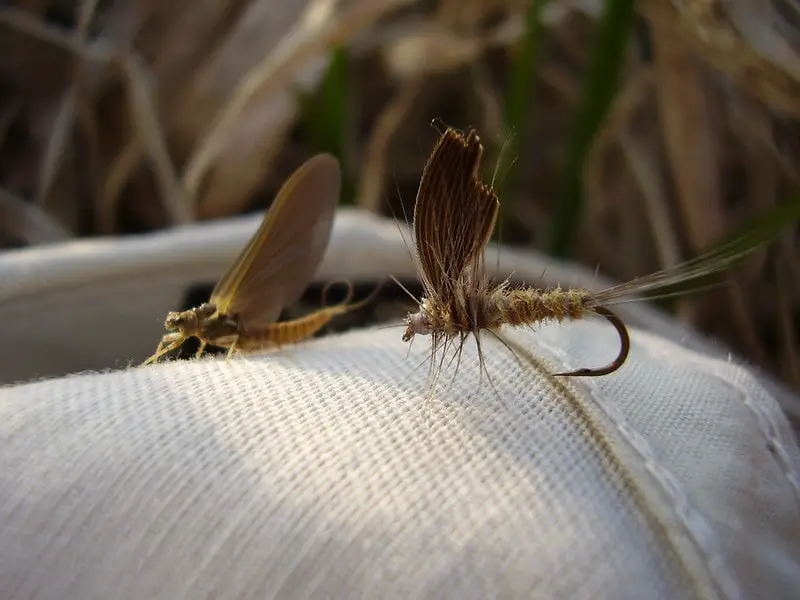
This basically means the same as matching the hatch, which means using flies that imitate the aquatic insects that the trout are currently feeding on.
Most trout anglers will use this method of choosing the right flies, and it does pay off.
To do this, there are often Hatch Charts available for your area that will give you a basic idea of the insect hatches, the sizes and colors of these insects, and the times when these insects are prevalent on the river.
Nymph For Trout: Certain flies like Pheasant Tail Nymphs are great because they can imitate many aquatic nymphs, and often, they will be a great fly anytime and on any river.
Nymph patterns can also include egg patterns, which can be very effective for catching trout when other freshwater species are spawning.
A fly fisherman should have an assortment of natural nymph fly patterns that include:
- Mayfly nymphs – Pheasant Tail Nymphs
- Caddis Larva
- Worms Patterns
- Egg Flies
Dry Flies For Trout: Dry flies are a bit trickier, but usually, an Adams fly, a March Brown, and an Elk hair caddis in sizes 12 to 16 are good options. Check out my top dry flies.
Guide Tip: The key is to match the size and color of the bugs on the surface.
The local fly shop will usually have all the natural fly imitations for your area, and these flies will help you catch fish.
7. Consider Attractor Fly Patterns
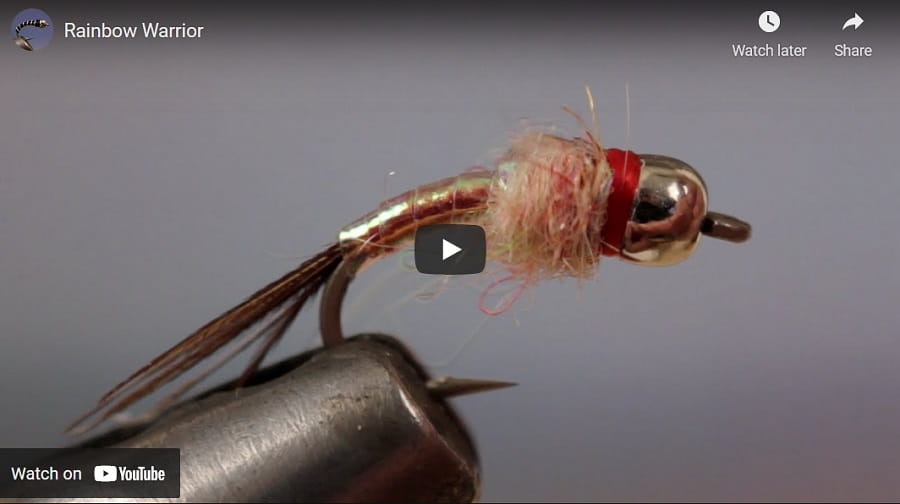
Unless there are a lot of the same hatching insects, also known as a hatch, I don’t bother trying to figure out what the trout are actually eating.
Instead, I’ll just use attractor patterns or generic fly patterns.
This could be a dry fly like a large fluffy elk hair caddis, a stimulator, or a Royal Coachman dry fly.
If it’s a nymph, something simple like a Prince Nymph, a Frenchie Nymph, or a Rainbow Warrior are good options that seem to work often.
Having an assortment of dry flies and nymphs, big and small, is a good option, and local fly shop employees should be able to make some recommendations.
Click the link for 29 of my most effective flies for trout.
8. Get Your Flies Deep and Down
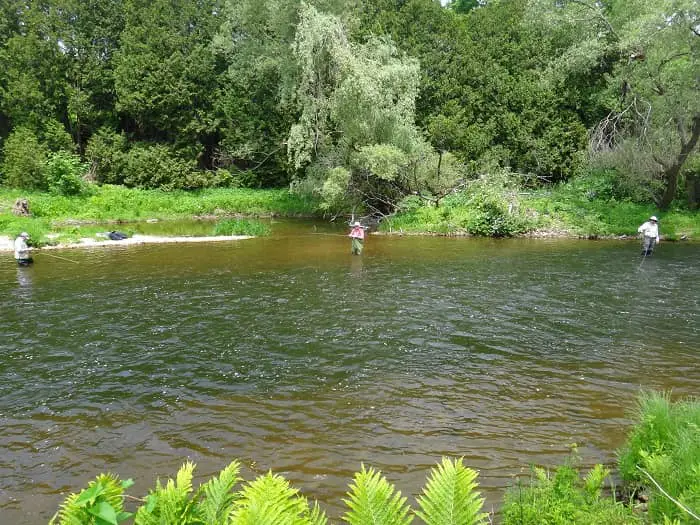
One of the keys to nymphing is to get your flies deep.
The reason for this is that most trout in a river will hold near the bottom, and they look and feed up and forward.
In my experience, the closer you can get your fly to the trout, the better.
To get deeper, consider a weighed fly instead of a non-weighted fly with weights on the line.
In some cases, depending on conditions and the mood of the trout, the trout will have a strike zone that is only 12 to 24 inches from them. This means if your fly is 25 inches over their head, it won’t eat it, so get deep, but DO NOT drag your fly across the bottom.
9. Slow Down Your Fly: Critically Important
I tell my clients and nymphing students that their goal when nymphing is to get their fly down fast, keep it at the speed of the bottom current, and keep it in the strike zone for as long as possible.
Learn to mend your line properly to control the speed of your fly, or use a method like Euro nymphing that doesn’t use an indicator or suspension device that will pull your fly too fast.
When dry fly fishing, it’s often critical to ensure your fly is moving at the speed of the bubbles.
Guide Tip: It is my experience that when nymphing or dry fly fishing, speed control is critical, and controlling your speed can ten-times the amount of trout you will catch.
10. Learn To Mend Well
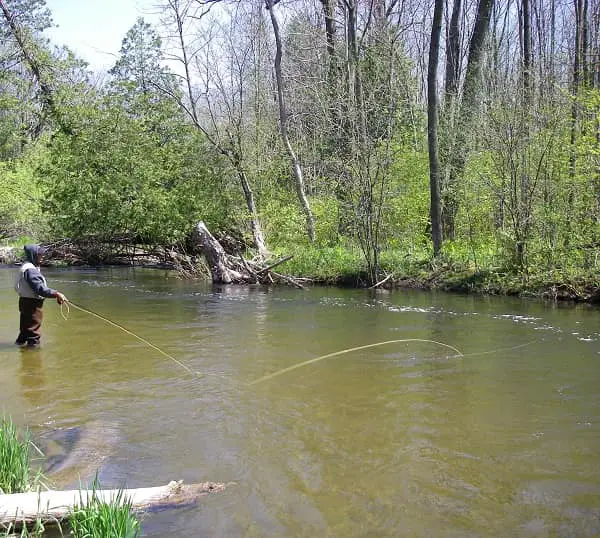
Mending simply means repositioning the line to get a more natural drift and to prevent any type of drag. Drag means any pulling of the line or pulling of the indicator, the leader, and the fly, caused by currents.
Mending can really only be done when using a floating line.
Mending is simply lifting and repositioning the line. 90% of mending is usually mending the line upriver, but not always, and it’s good to know which way to mend, and how much to mend, and what type of mend is best. See How To Mend.
11. Set The Hook Often
I’ve probably said this to a thousand anglers by now, “the guy who sets the hook the most will catch the most fish.”
After watching thousands of anglers fish, it’s my experience that many fly anglers miss a lot of fish because they simply don’t set the hook when they should.
Set the hook on anything and everything that looks unusual, and strike fast.
This means if your indicator is drifting along with the bubbles, observe how it’s moving. Anything different than that could potentially be a fish biting. This includes twitching or bouncing of the indicator, slowing, stopping, and even speeding up, which can all be caused by a fish so set on everything and set often.
12. Set Very Fast
Your fly is hard, and it has no taste or scent, and there is also a line attached to it. This is opposite to the aquatic insects trout eat every day, which are soft and possibly have flavor, a taste, or a scent to them.
Therefore, trout will grab your fly and spit it back out within a few seconds because they can quickly detect these abnormalities. For this reason, you need to set the hook as quickly as possible so you set it before the trout has a chance to spit it out.
13. Set Properly: Set Fast, But Set Lightly
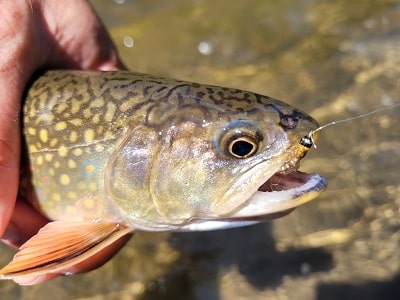
Setting the hook too hard can break light tippets on rocks or big fish, and setting too hard can also send your fly and leader up into the trees or shrubs behind you, or it can send your leader and fly into your rod. Both of which end up in a tangled mess or lost flies.
Based on my expereince, most anglers over-set, or set too hard.
Guide Tip: To hook a trout, once the fly is in the trout’s mouth, you only need to set the hook hard enought to move your fly 2 inches, that it!!!! 2 inches is all it takes to set the hook, you just need to move it fast so it penetrates.
Therefore, set the hook using a short arm stroke, don’t set lightly, set fast and short. See Setting The Hook.
14. Use The Right Cast
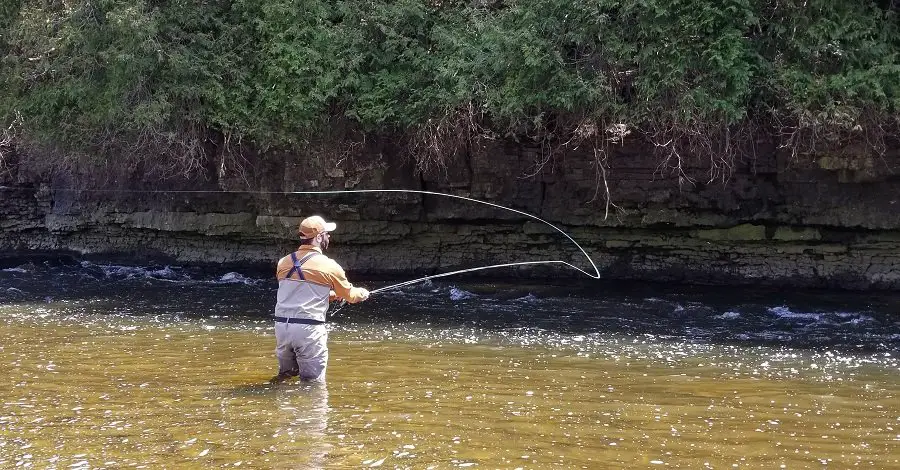
Don’t try to cast a nymph the same way you would cast a dry fly. Also, don’t cast your streamer the same way you cast nymphs or dry flies.
You will need to adjust your cast based on the size and weight of your flies.
15. Flip or Lob Cast When Nymphing
You need a slower cast when Nymphing, and you need to cast a shorter line!
To cast a nymph and indicator rig, let the line hang below you with your rod tip low, then strip the line in until you have about one to two rods length of line, drag the line with a medium speed by lifting your rod tip behind you and upriver then flip the line over and out.
Do NOT try to do a back cast a nymohng rig like you would with dry flies.
16. Learn The Roll Cast
Although the roll cast is used maybe 10% of the time, it is easy, and it’s worth learning.
The roll cast is often the best cast when you have trees or other obstructions behind you or above you and when a traditional fly cast won’t work.
17. Work On Your Cast and Accuracy

Dry fly fishing accuracy is important. I’ve watched fly fishermen target rising trout for an hour and they can’t catch fish.
The reason they are not catching fish is almost always because they can’t land the fly in the right spot in the feeding lane.
There are times when you will need to land your fly in a specific spot, like beside a log, or next to the edge of an undercut bank.
So, practice your cast so you will have an accurate cast when you need it.
18. Know Your Surroundings Before You Cast
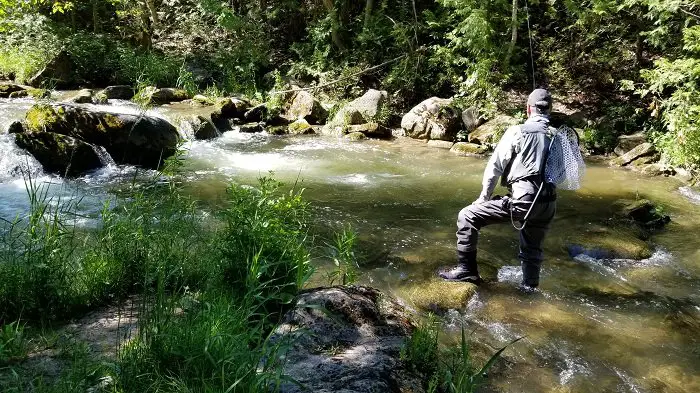
One of the big frustrations for beginner and intermediate anglers is catching their flies on everything except the fish.
This often means losing lots of flies and going through a lot of tippets.
You need to look around at anything and everything that you could potentially hook a fly on before you start fishing. Things like branches, rocks, trees, shrubs, or tall grasses. Then, either reposition yourself to avoid potential issues or change your casting angle.
Dry Fly Fishing
One of the oldest known methods of fly fishing, and still today one of the most popular and most fun ways to catch trout with a fly rod, is to do something known as dry fly fishing.
Dry fly fishing is best in the spring and summer which is when most insects are on the surface.
What is dry fly fishing?
Dry fly fishing simply means presenting your fly on the surface of the water.
19. Dry Fly Selection
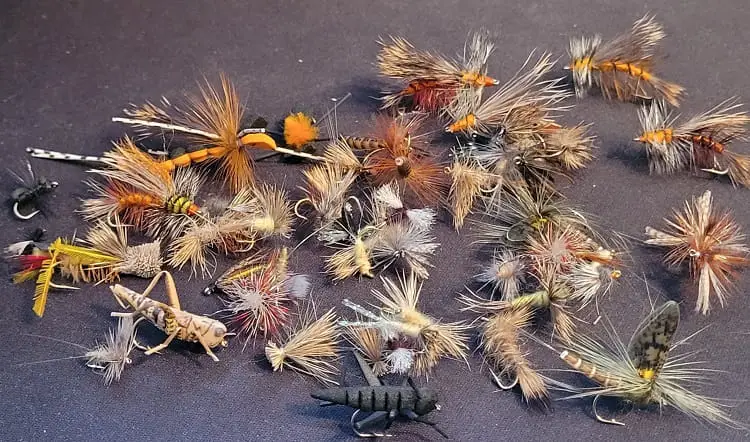
I’ve heard clients tell me they hesitated to learn fly fishing because they didn’t want to have to learn all the flies. Trust me, you don’t need to know any of the flies by name.
Even if you use the wrong fly, as long as you fish it well, there’s still a good chance a fish takes it on the first or second drift.
To encourage my new fly students, I tell them to observe what’s floating on the water or flying in the air and then try to do these three things:
- Match the size of the natural as best as possible.
- Match the shape or silhouette as best as possible.
- Match the color as much as possible.
Use a local hatch chart to help you decide what flies you need, and visit a local fly shop to pick the brains of the guys in the shop about fly selection.
Guide Tip: The bottom of the fly is what the fish see, and often, the bottom of the natural insect is lighter in color than the top of the insect, so when deciding on what fly to use, choosing a slightly lighter-colored fly is often better than choosing a slightly darker color.
20. See The Fly Better: 5 Guide Tips
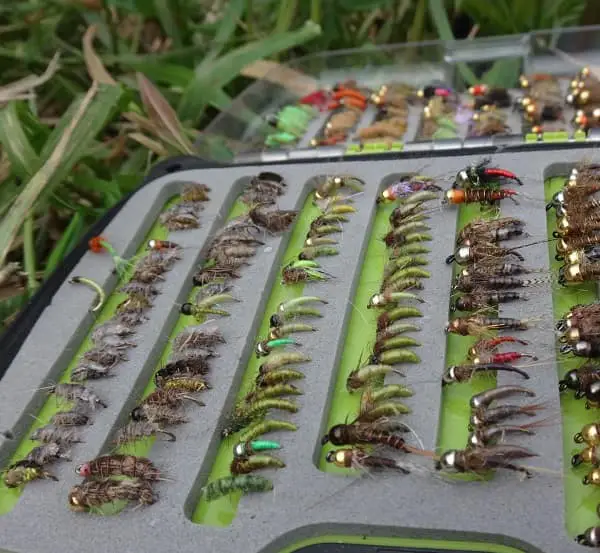
Small flies are very difficult to see, especially if you cast them out 30 or 40 feet or if there is glare on the water. If you can’t see your dry fly floating on the surface, catching trout is difficult.
It’s important to see your fly so you don’t miss a bite and so you can ensure your fly is drifting at the same speed as the natural insects.
Use these five tips to help you see your dry flies better.
#1. See It Land: When I’m guiding, I’m often able to see the fly much better than my clients because I have trained myself to keep my eye on the fly in the air.
If you want to be able to see your tiny fly on the water, make sure you see the fly land, if you see it land you can focus on the fly and track it. If you don’t see it land, trying to find the fly among all the bubbles or natural insects on the river can be nearly impossible.
#2. Glasses: Polarized glasses are an invaluable tool and will improve your ability to track and see your fly. My glasses not only allow me to see some very big fish feeding or resting below the surface, but they also help me see feeding or holding spots or potential snags.
#3 Hotspot: The trout see the bottom of your fly when you dry fly fish so adding a hotspot like orange yarn to the top of your fly will help you see the fly and should not affect the trout.
#4. Indicator: adding a small indicator 2 to 3 feet up the line when using micro flies is a great way to locate the area of your fly. If any fish rises in that area, you just set the hook.
#5. Set On Any And All Rises: If your fly is out on the water and you don’t know where it is, set on the rise. If you see a fish rise and if you don’t see the fly or know for sure if that fish actually grabbed your fly or not, just set the hook anyway and hope for the best
26. Use Dry Fly Dressing
I have found that most of the time, the higher your fly floats or sits on the surface, the better that fly works.
To keep your flies floating longer, use a good dry fly dressing also known as fly floatants. See my guide tips on making flies last longer when using dry fly floatant.
27. Use Longer Leaders and Thinner Leaders For Dry Fly Fishing
When dry fly fishing, your fly line is usually on the surface of the water, and since it’s often brightly colored and thick, it can be seen by the trout, and it can spook the trout.
Therefore, use a 9 to 13-foot leader with a 2 to 3-foot tippet.
Also, the tippet can leave a small indent on the water beside the fly, which the trout will sometimes see. This can spook the fish, so it’s always best to go as light as possible when dry fly fishing. Most guides will use 4X to 6X tippet which is about 2 to 6-pound test.
28. Targeting Fish Properly
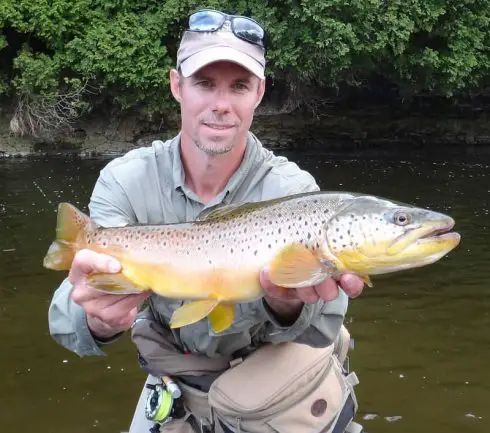
This is especially important when dry fly fishing but can be equally important with all fly fishing methods for trout.
And often, this is something most anglers don’t do well.
Any time you see a fish, whether it be a rising fish, or a fish feeding below the surface, or a fish you just saw swipe at your streamer, you MUST place your next cast 3 to 6 feet upstream of where you last saw that fish.
This is because fish look ahead of them by 2 or 3 feet, and they tend to look up. If you cast back at them after you see them and land your fly directly above their head or behind them, they won’t eat it, and it might even spook them.
I tell my clients to cast 3 to 6 feet above the trout and let the fly drift naturally toward them. This also ensures the fly doesn’t spook the fish when the fly hits the water.
29. Improve Your Dead Drift
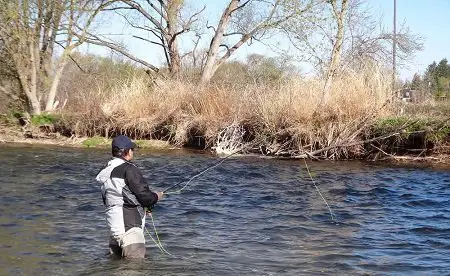
I sort of mentioned this above when I mentioned getting a dead drift and slowing your fly down while nymphing.
You almost always want your fly moving at the same speed as the natural insects, whether you nymph or dry fly fish.
Improving your drift when dry fly fishing can make a huge difference, but for a slightly different reason. If your dry fly drags across the surface in front of or over a large trout, it can spook the trout.
Therefore, you must learn to get a drag-free drift for as long as possible, and this is done with good line control and mending.
It’s also easier to get a dead drift when fly fishing if you cast upstream and across or straight upstream.
Often, only small fish will grab a fly that is dragging, and larger fish will ignore it.
30. Temperature
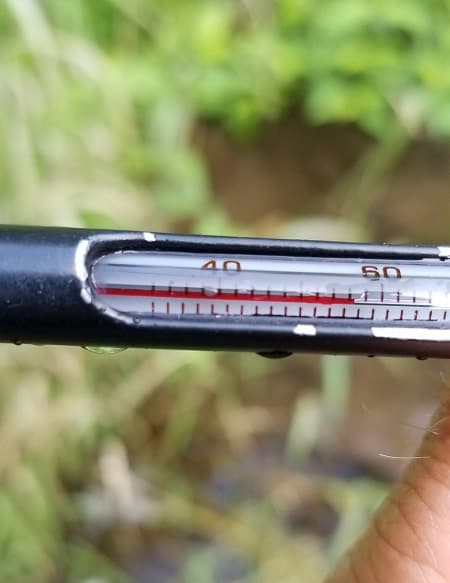
Trout are cold-blooded, and therefore, they are more active and feed when the water is at the ideal temperatures.
For many trout, the ideal temperature is 55F to 62F.
However, there are times when the trout will continue to feed in water as cold as 34F and as warm as 68F.
When the water is warmer than 65F, fighting fish can be very stressful and even deadly.
Anytime the water temperature is above 62F, and you plan on releasing a trout, you MUST keep the fish below the water surface while you get the hooks out.
Most fish that die after releasing them die due to prolonged exposure to air.
Fly fishing can get tough during the heat of the summer. You will find guide tips to help you catch more trout on my page, Hot Weather Trout Fishing Tips: What Guides Do.
31. Use A Net
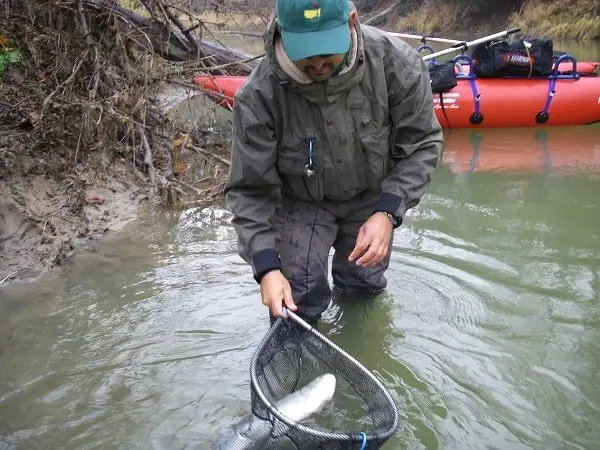
Nets help land the fish, and they keep the fish submerged in the water and alive so they can be unhooked and released healthy.
I have landed and released the same large trout 20 times a year because I handle them with care, and I couldn’t do that without a net.
Get a good trout net designed for trout fishing. See 5 Best Landing Nets For Trout.
32. Use The Right Gear
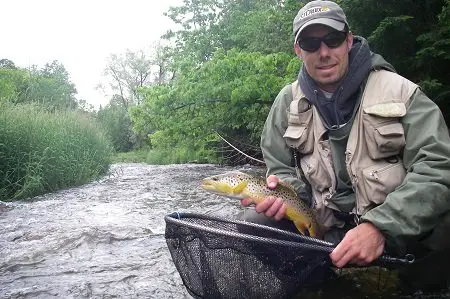
If you are going to fly fish for trout, you need to use the right gear.
Using the wrong gear can lead to less enjoyment, make it harder to learn, and can actually prevent you from catching fish.
Essential fly fishing gear includes the fly rod, the fly reel, and the fly line. These 3 things are unique to fly fishing.
Other non-essential gear includes waders, vests, packs, and fly boxes.
See all the fly fishing gear that guides recommend at Fly Fishing Gear: Everything You Need.
33. Use The Right Fly Rod
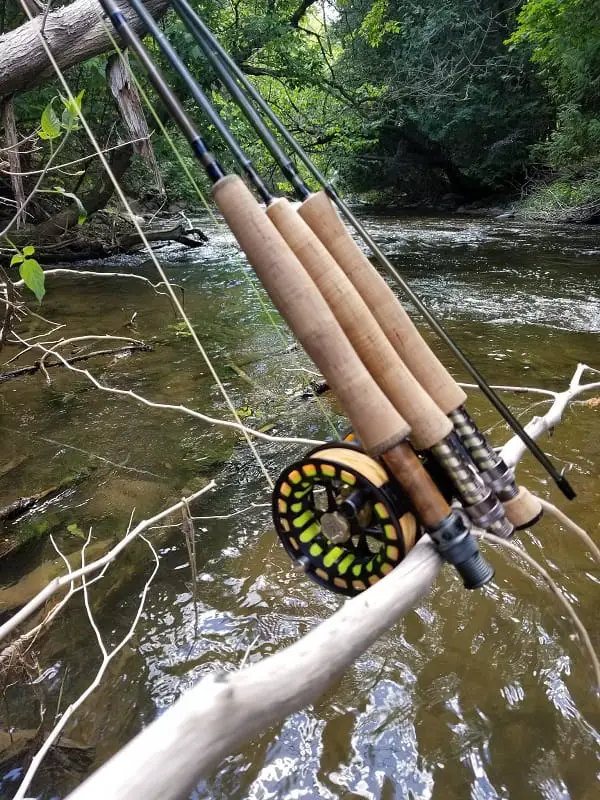
The fly rod is designed to cast the heavy fly line. The fly rod bends in a certain way that aids in the cast.
Fly rods are rated by a weight-rating system.
It’s not about the actual weight of the rod. It’s more about the weight of the fly line, which also uses the same rating system.
This is done so the rod and line are matched up better. The right line on the right rod will cast easily and will cast well. The wrong line will make it difficult to cast.
Therefore, for most trout fishing, the ideal rod will be a 9-foot, four or 5-weight rod matched with a 5-weight line. Some methods will require a longer or shorter rod or a heavier or lighter-weight rod.
See my recommendations for the best fly rods for trout.
34. Use The Right Fly Line
Fly lines are usually 90 feet long, and they come in multiple weights. They can be either an all-floating line, a partially sinking line, or a full sinking line. They can also come in what is called a weight-forward fly line or a double taper line.
For most trout fishing, you will want a full-floating fly line that uses a weight-forward taper. With this fly line, you will be able to fish all methods.
Partial sinking lines, also known as intermediate fly lines, and full sinking lines, are mostly used for wet fly fishing and streamer fishing in lakes, ponds, and on large rivers.
35. Use The Right Reel
Some anglers will tell you the reel just holds your line, I disagree.
A good reel will also help you land fish, especially if it has a good smooth disc drag.
Your reel should also be the right size for the rod and line, which is why fly reels also come with the same weight-raring system.
Having the right reel will balance out the rod and make casting and fishing more fun.
36. Be Stealthy
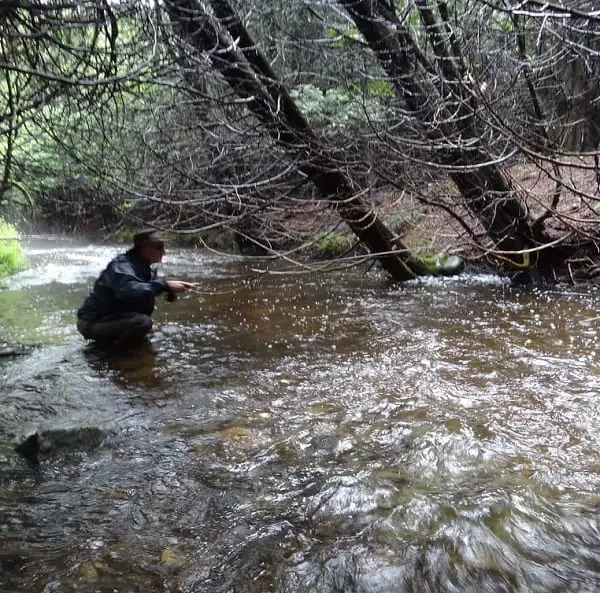
Even if you have a great fly on, and you have it set up perfectly, and you fish it really well, if you have spooked the big trout when you arrive at the spot, they won’t bite.
A key to catching trout is actually to be stealthy.
I have said this many times. “Many anglers spook the big trout and make them go lockjaw before they even make their first cast.”
So, move slowly, be very quiet, approach from below, and be in position.
37. Be In Position
Being in the right position to both present your fly effectively and not spook the trout is important. Even rainbow trout that don’t spook as easily will still spook if you are standing in the wrong spot.
Whenever possible, stay behind the rainbow trout and fish upstream. Rainbow trout, like all trout, look upriver and sideways, so if you’re in the line of sight, it can spook them. Stay behind the trout, and you will catch more.
The exception is when wet fly fishing and sometimes when streamer fishing or on very large and deep rivers.
Wet Fly Fishing
Wet fly fishing is kind of an old-school method, and other than some of the older fly fishermen, I don’t see wet fly fishing done very often.
Wet flies are meant to be cast across and slightly downstream and then swung across the river.
With wet fly fishing, you fish downstream and let your fly swing lower and lower with each consecutive cast.
Streamer Fishing
Streamer fishing is used on rivers, lakes, and ponds, and it is often a method that will catch the largest trout. Streamer fishing is also the method most used for other freshwater species like pike, bass, and musky.
What is Streamer Fishing?
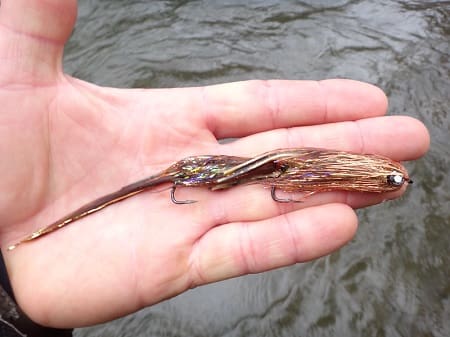
Streamer fishing uses larger flies that imitate swimming baitfish, leeches, crayfish, and even a mouse.
You simply cast out your streamer fly and strip it in. Stripping refers to short pulls of the line to create a swimming-type action to the streamer fly.
Many larger trout are caught on streamer flies like the Muddler minnow, Zoo Cougarm bunny leech, and Wooly bugger.
Streamers are also a great way to find fish because you can cover a lot of water with a streamer fly.
All species of trout, salmon, and arctic char will chase and eat streamers. If you want to learn more, check out my article on the best streamers for trout.
38. Use A Shorter Leader
When streamer fishing, for casting accuracy and ease of casting, it’s better to fish with a short leader between 6 and 10 feet long.
39. Reading the Water
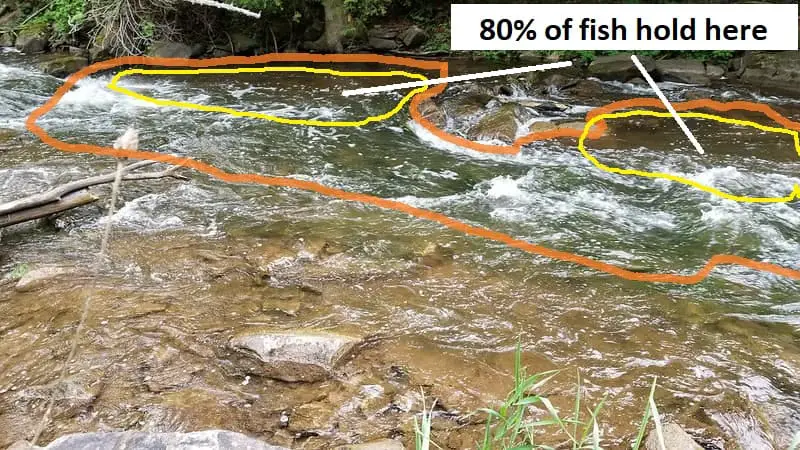
Reading the water means locating areas of the river where trout will hold or feed.
New fly anglers might find this tricky, but you can use rocks, logs, and currents to help you find these areas.
Often, reading the water is simply seeing where the river goes from shallow to deeper. Darker water means deeper water, and this is where trout like to hold.
40. Fly Fishing Through The Seasons
Fly fishing can be done all year round, but in some areas, fly fishing in the winters can be extremely cold, and the summers can be extremely hot.
You need to adapt to the conditions if you want to catch trout consistently. The trout can hold in different areas, feed on different foods, and eat at different times of the day.
As an example, in late spring and summer, the fishing can be fantastic at dawn, but in the winter the best fishing is often later in the afternoon.
If you have any questions or tips, let us know in the comments section below.
Tight Lines,
Graham
